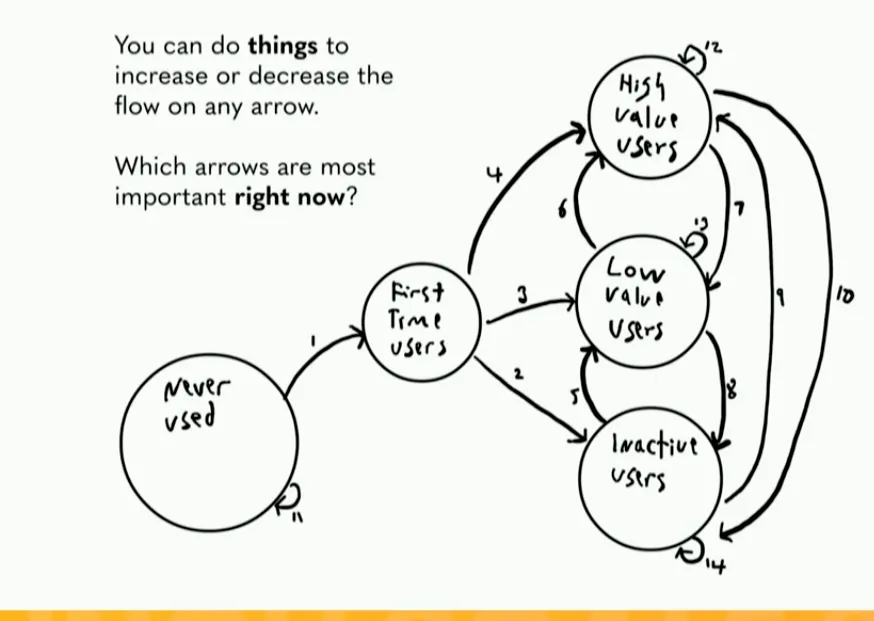(2020-07-21) Libin Presents His Model to Answer All Startup Growth Questions
Phil Libin presents (video) his Model to Answer All Startup Growth Questions. (cf Growth Hacking, Business Model, System Dynamics). He makes a State Machine which basically tracks the number of users flowing each month among various states (low-value user, high-value user, inactive)....
5 states: never-used, first time users, inactive, low-value, high-value
- note he's mixing revenue and usage together so far - so, taking EverNote as an example, a high-frequency non-paying (freemium) user is low-value; is a paying-but-low-frequency user also low-value? Do they become high value over time (by paying many months of membership)?
- ah, he's actually framing it as customer who's receiving high-value from you
- ideally that's a good exchange - shared value, "well-aligned"
- (he also notes that EverNote considered high-value users to be people using the app 20/month, which they found predicted revenue/retention)
14 state transitions (including staying-in-place), every human can be assigned one of those paths every month (his cadence of choice)
- what if someone moves from never-used, through first-time-user, through to high-value-user all in the same month? Maybe he's assuming there aren't many business models like that....
- in Q&A he says "you stay in first-time-user for the whole month, and then their new state is what their 2nd-month behavior is"
- note he's using calendar-month rather than days-since-join (cohort) - a simplification but that's probably ok
- you might need a slower cadence if product usage tends to be less-than-monthly
- this might put toward more of a cohort-based model (though that would be much more complex)
- or maybe you just know you'll have lots of motion between inactive and high/low-value....
- (that's a challenging business model because it's hard to maintain/reinforce a user habit).

You can track those 14 metrics every month. (Probably as a % of starting-state-count.)
Every transition is good or bad. (staying-low-value could go either way, depending on your unit economics).
You can target each of those flows with interventions.
But where should you focus your efforts?
Many startups over-focus on the flow from non-user to first-time user (Activation, flow 1).
Most should focus on reducing the flow from first-time-users to inactive (flow 2). (Because if you're leaking too much of this, it kills the value of flow1.)
- He frames this as the Bounce rate, and different from Retention-Churn, which he limits to people who had "more" activity going inactive. (Is action2 enough to count? Or 2 months with any activity? Does this relate to hitting the Aha moment?)
- "This is often a failure of expectation-setting." (and/or targeting)
- (also he notes that you should also measure Churn from high-value separately from Churn from low-value: flows 8 vs 10)
- should generally aim to get Bounce rate below 30% before paying much attention to other flows
Don't forget to work on Resurrection (flows 5 and 9). Over time, a large pool of Inactive users is often cheaper to convert back to low/high-value than the people who've never used you.
Upgrade (low to high, flow 6)
Downgrade (high to low, flow 7)
Bullseye (first-use to high-value, flow 4): found at EverNote that this was a better focus than Upgrade.
High-value Retention: flow/loop 12. This is the long game.
Can do this with money-flow, too. Each transition has a marginal/unit cost and marginal/unit revenue, multiply by the person-flows.
Can also use this to frame User Journeys: each journey is a series of transitions. "Why did this happen?"
He starts with 27min of talk, then it goes to Q&A.
Edited: | Tweet this! | Search Twitter for discussion

 Made with flux.garden
Made with flux.garden